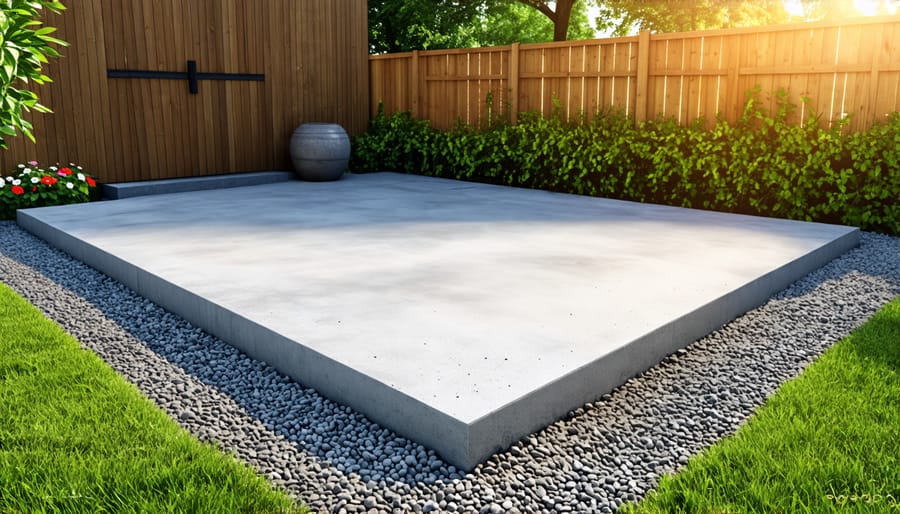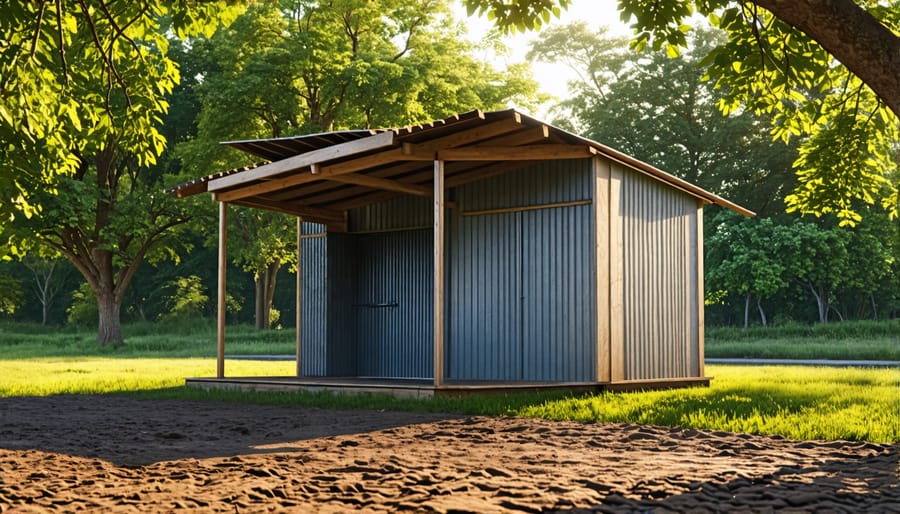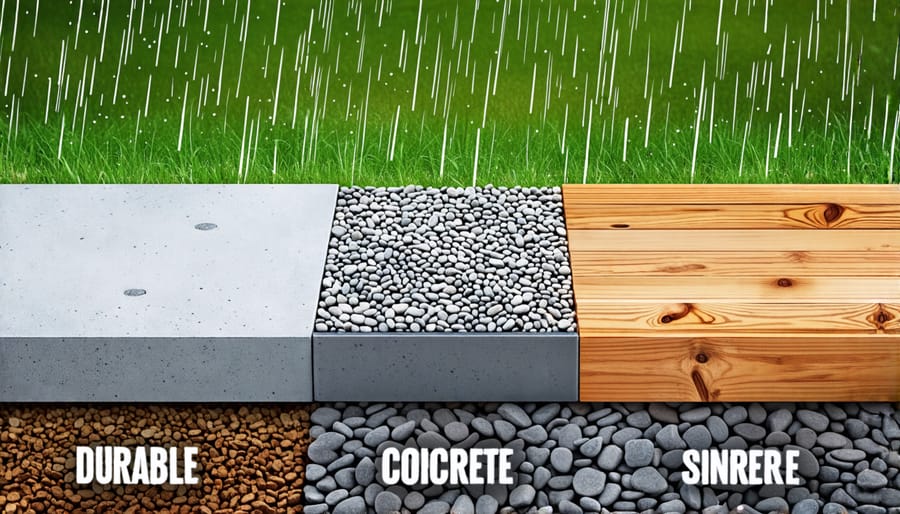Determine the shed’s size and weight, assessing if the ground can support the structure without a foundation. Identify the terrain and weather conditions, opting for a foundation if your area experiences heavy rain or frost, which can destabilize the ground over time. Evaluate how you’ll use the shed; a foundation may be necessary for heavy equipment storage to ensure stability and prevent rot. Calculate your budget and time, weighing the long-term benefits of a foundation against initial costs. Seek testimonials from other DIY enthusiasts to gain insight into their choices and outcomes, helping you validate your decision process.
Understanding Shed Foundations
Types of Shed Foundations
When deciding on the foundation for your shed, you have several practical options to consider, and choosing the right one can make all the difference in its stability and longevity. A popular choice among DIY enthusiasts is the concrete slab foundation. Concrete provides a durable, level surface, perfect for larger sheds or those storing heavy equipment. If you’re looking for something a bit more flexible and easier to install, gravel pads might be the ideal solution. They offer excellent drainage, preventing moisture build-ups that can damage your shed. Wooden bases, made from pressure-treated timber, are another great option, especially if you’re aiming for a more elevated structure that keeps critters away. Each type has its unique benefits, so understanding your needs is crucial. Explore further into which might be the best foundation for a shed by considering your specific environmental conditions and storage needs.

Benefits of a Proper Foundation
Establishing a proper foundation for your shed offers a multitude of benefits that can greatly enhance the structure’s performance and longevity. First and foremost, a solid foundation provides exceptional stability, ensuring that your shed remains level and secure, regardless of the weather conditions. This prevents warping or shifting that could compromise its integrity over time. Moreover, a well-constructed foundation is crucial for safeguarding your shed from moisture. By elevating the structure and allowing for proper drainage, you can effectively keep water out, thus preventing the onset of rot and decay. This is especially important if you store valuable tools or equipment inside. Additionally, investing in a proper foundation enhances the longevity of your shed. A stable, dry base minimizes wear and tear, enabling your shed to withstand years of use. Ultimately, a sound foundation is a prudent investment, offering peace of mind and ensuring your shed stands the test of time.
When You Need a Shed Foundation
Climate and Weather Considerations
When deciding if you need a foundation for your shed, consider the climate and weather conditions in your area. In regions with heavy rainfall, a foundation can prevent water from seeping into the shed, helping maintain its structure and your belongings dry. Cold climates with freeze-thaw cycles might cause ground shifting, leading to structural issues like warped doors or windows; a sturdy foundation can help mitigate these challenges. In windy areas, a foundation adds essential stability, anchoring the shed against strong gusts and potential tipping. On the other hand, if you live in a region with mild, stable weather, the need for a foundation might not be as critical. Evaluating your local climate is a practical step to ensure your shed stands the test of time and elements.

Shed Size and Structure
When deciding whether your shed needs a foundation, size and structure play crucial roles. For smaller sheds, particularly those used for light storage or simple gardening tools, a basic foundation might suffice or even be unnecessary. However, as your shed size increases, so do the demands for stability. Larger structures, especially those intended for heavy equipment or as a workspace, require a more robust foundation to prevent shifting or settling. The material of your shed also matters. Wooden sheds, for instance, benefit greatly from a solid base to avoid moisture damage, while metal sheds might just need a simple, flat surface. One homeowner found that their 10×12 wooden shed remained level during heavy rains thanks to a concrete slab foundation. Consider your needs carefully; the right foundation will extend the life and functionality of your shed.
When You Can Skip a Foundation
Soil Conditions
For those lucky enough to have naturally stable and compact soil, like clay or loamy soil, your shed might stand firm without a formal foundation. These soil types provide a solid base that can maintain its shape, especially in areas with minimal freeze-thaw cycles or heavy rainfall. If your soil is consistently level and drains well, you could consider placing your shed directly on the ground, using pressure-treated beams or other moisture-resistant barriers to prevent direct soil contact. Before moving forward, it might be wise to chat with a neighbor or local builder who successfully skipped a foundation to get their insights and experiences.
Temporary or Small Sheds
Small or temporary sheds often don’t need a traditional foundation, which can save time and effort during installation. For lightweight sheds that you might use for storing garden tools or as a seasonal retreat, compacted gravel or wooden skids can be sufficient. These solutions provide a stable base while ensuring easy relocation if necessary. However, be mindful of the ground conditions and weather in your area; proper drainage and support are essential to prevent your shed from sinking or shifting. Consider speaking to local DIY enthusiasts who’ve had success with such setups for real-world insights and experiences to guide your decision.

How to Decide the Right Path for Your Shed
Evaluate Your Landscape and Shed Use
Before deciding on a shed foundation, take a moment to evaluate your landscape and how you plan to use the shed. Start by examining the ground where your shed will be placed. Is it level, or does it slope significantly? A sloped or uneven surface can lead to structural issues over time. For example, installing a foundation can prevent settling and shifting, ensuring your shed remains stable.
Next, consider what you’ll store in the shed. Is it just for garden tools, or will it house heavier equipment? Heavier loads may require a sturdier foundation. On the aesthetic side, a well-constructed foundation can enhance the overall look, making your shed appear as an integral part of your garden.
Think about the local climate, too. Areas prone to heavy rain might benefit from a raised foundation to improve water drainage. By evaluating these factors, you can make an informed decision, ensuring your new shed is both functional and beautifully integrated into your landscape.
Cost and Time Considerations
When deciding whether to lay a foundation for your shed, two major considerations come into play: cost and time. Opting for a foundation often increases the upfront expense, particularly if you require specific materials or professional help. However, you might save by doing it yourself, especially if you already have some DIY experience. The cost can vary widely depending on the size and type of foundation you choose—ranging from simple gravel bases to more permanent concrete slabs. Sometimes, hiring equipment is necessary, and understanding the excavator cost can help budget accordingly.
Building a solid foundation takes time, potentially adding days or even weeks to your project, particularly if weather conditions aren’t ideal. Still, this investment can pay off by extending your shed’s lifespan and ensuring it remains durable and level throughout its use. For a quick and cost-effective solution, some homeowners utilize pavers or skids, balancing affordability with durability. By evaluating these factors against your budget and timeframe, you can make an informed decision that meets your needs.
Conclusion
In conclusion, deciding whether to build a foundation for your shed is a crucial step in ensuring its longevity and functionality. As we’ve discussed, factors such as shed size, ground conditions, and intended use play an essential role in this decision. For instance, if you’re storing heavy equipment or planning to use it as a workspace, a sturdy foundation becomes more important. Other real-life use cases have shown how a well-chosen foundation can prevent issues like water damage or structural instability. It’s essential to think about your specific needs and conditions before making a choice. Always feel free to ask questions or consult with a professional if uncertainties remain. Remember, selecting the right foundation not only enhances the shed’s durability but also contributes to its aesthetic appeal and utility in your backyard. So take the time to evaluate your options carefully, ensuring your shed is both a practical and beautiful asset.





Leave a Reply